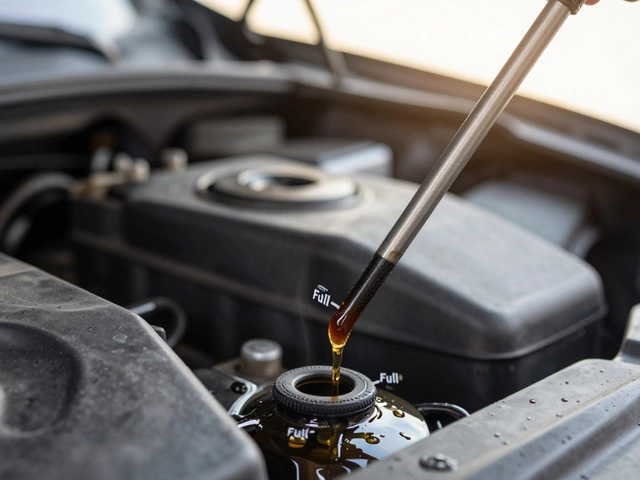
Keeping your car in prime condition often boils down to regular maintenance, especially when it comes to engine oil. But there's more to it than just pouring oil into your car; timing is crucial. How long should you let your car sit after adding oil? This simple question could significantly impact your engine's health.
Leaving your vehicle idle post-oil addition isn't just a myth. Factors such as oil type and engine temperature could play a role in how long you should wait before hitting the gas. Dive into the details and learn how this small adjustment can ensure your car runs smoothly for miles to come.
- Understanding Engine Oil Basics
- The Ideal Waiting Time
- Factors Influencing Oil Settling
- Practical Tips and Best Practices
Understanding Engine Oil Basics
When you think about maintaining your car, the first thing that often comes to mind is the engine oil. This slick golden liquid is the lifeblood of your vehicle, and for many good reasons. Engine oil not only lubricates the moving parts of an engine but also cools, cleans, and protects it. It forms a barrier between components to minimize wear and tear. Likewise, keeping your engine clean is another vital role it plays by trapping dirt and microscopic debris that could damage the engine over time. You might be keen to take your car out for a spin right after changing the oil, but understanding the basics of engine oil might make you reconsider the wait.
There are several types of engine oils available today, each serving a distinct purpose. The most common types include conventional, synthetic, and blended oils. Conventional oil is refined from crude oil and is suitable for cars with simple engine designs. On the other hand, synthetic oil is chemically engineered to offer superior protection and performance, especially under extreme conditions. The blend of synthetic and conventional oils offers a balance between performance and cost. Each type has its own characteristics that cater to different car engines, driving conditions, and maintenance practices. That said, no two oils are the same, and choosing the right type for your car is crucial to its health and performance.
Why Engine Oil Matters
Engine oil is not just about lubrication. Its operation within the engine is a complex phenomenon and serves multiple functions that are integral to an engine's longevity. Car maintenance without proper oil management is akin to running an engine on bare metal. Beyond minimizing friction and wear, it helps in heat dissipation. When your car runs, thousands of small explosions occur every minute, generating a remarkable amount of heat. Oil acts as a coolant by evenly distributing that heat away from critical components. This heat management extends your engine's life and efficiency.
The American Petroleum Institute (API) notes, "Regular checks and oil changes are crucial to maintaining optimal vehicle performance and longevity."
Engine oil's cleaning properties can't be overlooked either. As it circulates, it picks up sludge and particles that accumulate over time. This cleaning action prevents these from forming deposits and leading to engine damage. Oil’s protective qualities also include preventing corrosion from happening inside your engine. Besides, modern oils come equipped with a broad spectrum of additives that enhance these capabilities, ensuring your engine remains in peak condition.
| Oil Type | Best For |
|---|---|
| Conventional | Simple engines, typical city driving |
| Synthetic | High-performance engines, extreme climates |
| Blended | Best of both worlds, cost-effective performance |
In the end, while it's tempting to rush out and drive after adding engine oil, taking a moment to let it settle is one of the simple practices that can keep your car healthy. Understanding these basics not only gives you a better appreciation for the internal workings of your vehicle but also empowers you to make decisions that prolong its life. As the saying goes, knowledge is power, and in the world of car maintenance, it's the power to ensure a smooth drive every day.

The Ideal Waiting Time
After topping up your engine oil, the question of how long to let your car sit before driving it can be crucial. While it may seem like a minor detail, this short waiting period helps ensure the oil is properly settled in the engine. An immediate drive can lead to uneven distribution, which might not provide the optimal lubrication your car engine needs. Typically, letting your vehicle sit for about 5 to 10 minutes can be beneficial. This allows the oil to drip down from the fill point to the oil pan, where it can be efficiently pulled through the engine when started.
Many experienced auto enthusiasts recommend a wait time that matches the amount of oil added. For instance, if you’re adding a quart, a good rule of thumb is to wait 5 minutes. This timing isn’t just a random guess; it’s considered a sweet spot for most passenger vehicles. Over this period, oil begins to coat the engine's moving parts, forming a protective film that's essential for reducing friction and wear. Waiting a bit longer won't hurt but jumping the gun might lead to mishaps if the engine hasn’t received its vital lubrication.
It’s interesting to note that the type of oil used can also affect your waiting time. Full synthetic oils are designed to offer quicker flow into the engine's tightest spots, potentially reducing the necessary waiting period. Yet, it’s always worth erring on the side of caution, especially given the investment a car represents. As the AA emphasizes, “allowing time for the oil to settle aids in achieving better vehicle care.”
“Protecting the engine is crucial, and one cannot underestimate the role a few minutes can play in ensuring the vehicle's longevity.”this simple step can save car owners significant sums in repair costs in the long run.
While this waiting process is happening, it’s an excellent time to check potential leaks. Monitoring the ground beneath the car can help spot drips that might indicate improper seals or other issues. A quick glance now can save a lot of frustration later. Remember that maintenance is about vigilance and taking the necessary small steps to prevent larger issues in the future. It’s a package deal – topping off oil, letting it settle, and being observant about your car maintenance routine.

Factors Influencing Oil Settling
Understanding the factors that influence how quickly or slowly engine oil settles into a car's system can help you optimize your vehicle's performance and prolong its lifespan. One of the key factors is the type of oil used. Different oils have varying viscosities and chemical compositions; synthetic oil, for instance, tends to blend more seamlessly with existing oils, which might negate the need for a prolonged wait. In contrast, conventional oil may require a little more time to distribute evenly, especially in colder climates where the liquid is more viscous initially.
If you let your car sit after an oil change according to the specific type of oil in use, you might see a marked improvement in efficiency, according to automotive expert John Nielsen, who states, "Modern synthetic oils often don’t require a lengthy settling period, which is a great advantage for busy drivers."
The engine's temperature prior to adding oil is another significant factor. If you've just returned from a drive, the heat causes the oil to be more fluid, allowing it to flow swiftly through the engine's passageways; thus, the waiting period might be shorter. On the other hand, adding oil when the engine is cold – such as first thing in the morning – means that it might take longer for the oil to become adequately distributed, suggesting it’s best to wait a tad longer before starting up again.
Moreover, the design of your vehicle's oil system plays an essential role. Cars designed with advanced lubrication systems may allow oil to settle more efficiently, while older models might require you to be more cautious. Routine maintenance and understanding your car's unique requirements can be crucial in ensuring the oil settles appropriately and fulfills its function of reducing friction and wear. A simple habit such as regular checking of your dipstick can give quick insights into whether the level has properly leveled off and is ready for the engine's demands.
It’s worth noting the ambient conditions like temperature and altitude, too. Lower temperatures can increase oil thickness, delaying settling, while high altitudes might affect the pressure in the ways your engine operates. Drivers in regions where temperatures fluctuate significantly or who often drive up steep gradients might need a tailored approach. This can include letting the car sit longer during specific conditions to guarantee efficient oil circulation throughout the engine.
For those who like to get meticulous, having a dashboard oil monitor or installing aftermarket oil pressure gauges could be a worthwhile investment. These indicators give real-time insights into how well the oil is flowing and when it achieves the ideal settling state. Advanced cars with digital assistants can also alert you when it's optimal to start driving again post-oil change, saving the guesswork for those less mechanically inclined.

Practical Tips and Best Practices
Ensuring your car runs smoothly isn't just a task; it's a journey marked by smart choices and timely interventions. Properly maintaining your vehicle involves understanding the nuances of basic care routines, including the sometimes overlooked step of letting the car sit after adding engine oil. Yes, the time you give your engine to settle can make a world of difference in performance, durability, and efficiency. Here are some practical tips to consider. First, when you add engine oil, make sure the car is parked on a flat surface. This allows the oil to distribute evenly across all engine components. If your vehicle is on a slope, the oil may pool in certain areas, causing uneven distribution and not adequately lubricating all parts. Mixing different types of oil can sometimes be inevitable, but try to avoid it. Consistency is key, and using the same brand or type of oil provides your engine with uniform viscosity, ensuring smooth operation. It's worth mentioning that it's always a good idea to have spare oil of the same type in your garage. Driving habits matter too; accelerated driving right after adding oil can cause it to splash around rather than settle, so be gentle on the throttle initially.
Monitoring your vehicle's oil level regularly is another habit that yields huge benefits. After adding oil, checking the dipstick will give you insights into whether you've reached the optimal level. Moreover, it's advisable to get a sense of your car's rhythm — new noises or rough idling may imply oil distribution issues. Additionally, schedule your oil changes based on your car's manufacturer's recommendations. Following a regular maintenance schedule rather than waiting for signs of poor performance can help prevent engine wear and tear. Did you know that about 60% of car break-downs are attributed to delayed attention to engine oil levels? This statistic emphasizes the necessity of proactive care.
At times, the variety of oil change options available can be overwhelming. Whether it’s synthetic or conventional, choosing the right oil type largely depends on your car's age, the climate in your region, and your driving habits. Modern cars usually benefit from synthetic oil, which offers better thermal stability and doesn't break down as quickly as conventional oil. This can be especially important in extreme weather conditions, ensuring your engine performs optimally throughout seasonal shifts. Regularly review your owner’s manual where the manufacturer provides guidance tailored specifically for your vehicle model. As an expert from MyCarNeedA.com once stated,
"Engaging in routine checks and choosing the oil best suited for your car can extend your vehicle's lifespan, saving you hundreds over time in repair costs."Remember, being informed and attentive not only saves money but also enhances your car’s reliability.





